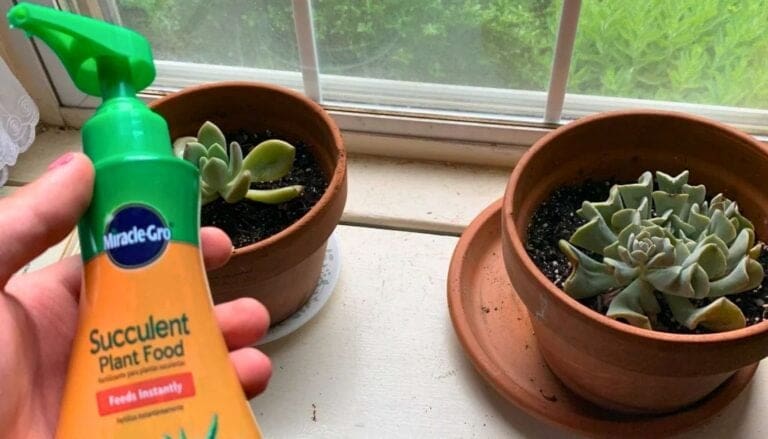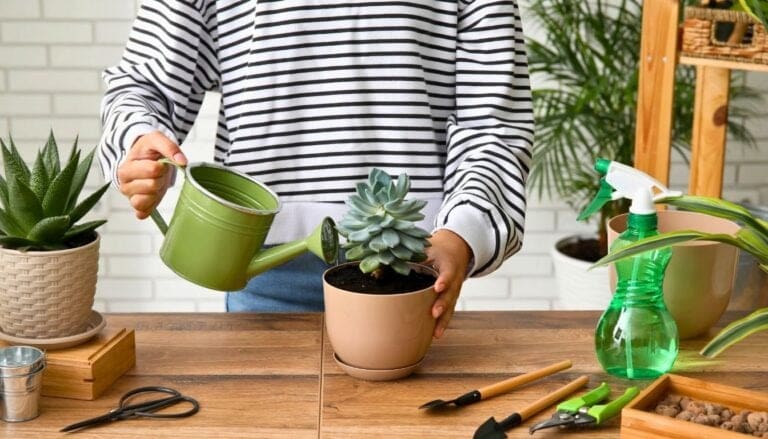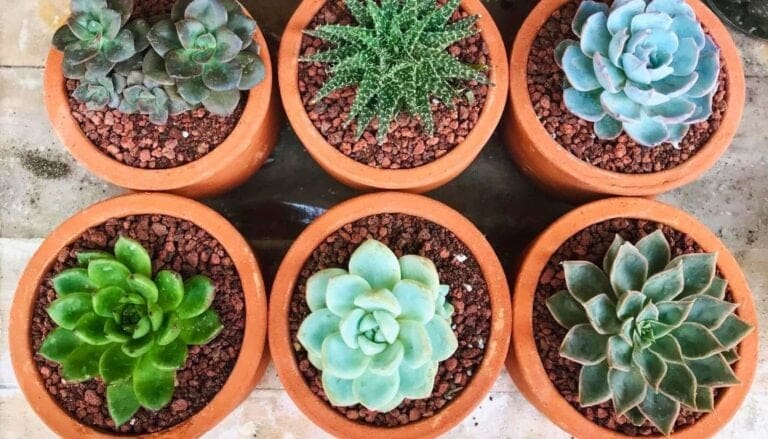Winter-Proof Your Succulents: Essential Tips for Cold Weather Survival
I’ve got a confession: I’m a bit obsessed with succulents. These little green gems are so low-maintenance, yet they brighten up any space.
Yet, the real challenge comes in winter! ❄️
Ever wondered how to keep these beauties alive when it’s freezing outside?
Don’t worry, I’ve been in the same boat.
The key to winter-proofing your succulents is to protect them from frost, reduce watering, and ensure they get enough light.
Sound easy enough? Stick around, and I’ll guide you through each step with simple tips and tricks.
Do you have any sneaky tricks for keeping your succulents happy during winter? Share them in the comments!
Let’s create a cozy winter plan for our plants and enjoy watching them thrive, even when it’s chilly. 🌵👇
Please note: Simplify Plants is reader-supported. As an Amazon Associate, I earn from qualifying purchases made by our readers with no extra cost added to you all! Some links in the post are affiliate links and I get a commission from purchases made through links in the post.
Understanding Succulents and Cold Weather
When winter comes, succulents might seem like they’re in their element, but cold weather can be tricky for them.
Let’s explore how these tough little plants cope and why some are more resistant to cold than others. 🤔
Traits of Succulents in Winter
Succulents usually have thick leaves that store water. This helps them survive dry environments, but winter poses a different challenge. 🌨️
When it gets chilly, water inside their leaves can freeze. This may cause damage if they aren’t cold-hardy.
In the winter, I always make sure my succulents are in a safe spot.
Most succulents need less water during winter because they rest during this time.
Keep an eye out for signs of too much moisture, like mushy leaves.
If your succulents are outside, make sure they’re sheltered from frost.
Do you have a favorite spot where you keep your plants when temperatures drop? Let me know! 😉
Why Some Succulents Are More Cold-Hardy
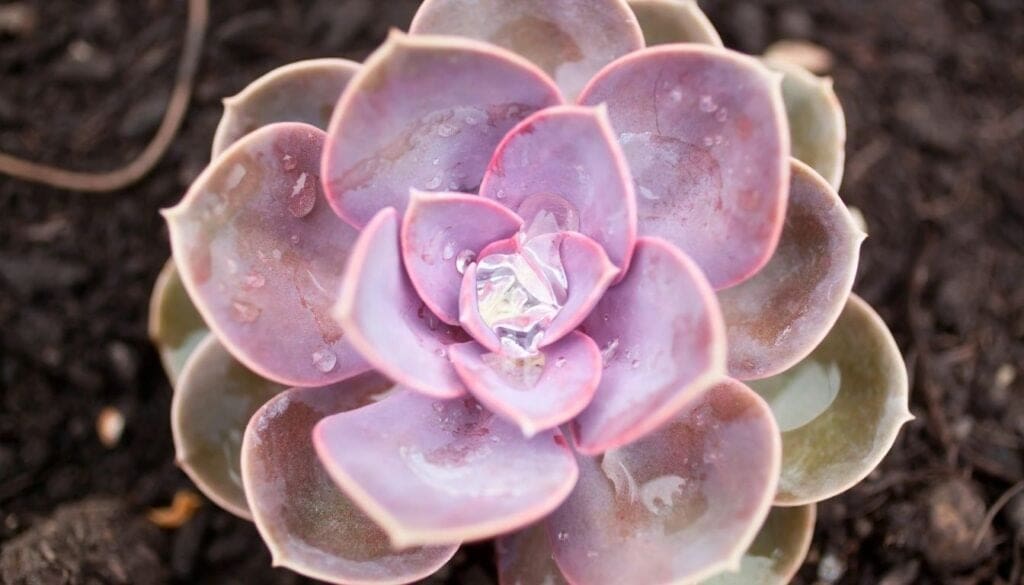
Some succulents are like nature’s little superheroes. These types have adapted to handle colder temperatures.
For instance, sedum and sempervivum are known for their ability to withstand low temperatures.💪
Their secret weapon? Changing leaf colors and having antifreeze-like chemicals.
Ever notice your succulents change color in the cold?
They turn red or purple because pigments help them handle the sun and cold better.
If you’ve seen this transformation, post a pic in the comments. I’d love to see them! 📷
So next time winter rolls around, let’s keep these traits in mind.
Understanding what each succulent needs can help them thrive no matter the weather.
Can’t wait to hear your winter-proofing tips! 🌵✨
Signs of Cold Stress in Succulents
I’ve learned that during colder months, succulents can show signs of stress if not cared for properly. Let’s explore how we can spot these signs and when it’s time to take action to save our leafy friends.
Recognizing Symptoms of Cold Damage

One of the first things I look out for is discoloration.
Do you ever notice your succulents turning odd colors, like red or purple? This might not be due to a makeover attempt by Mother Nature! Instead, it could be a sign of cold damage. 🌱
The leaves can also become soft or mushy when exposed to too much cold.
If your succulent leaves start drooping or become squishy, it’s time to move them to a warmer spot.
Did you ever feel that squishiness and just know something’s wrong? That’s their way of asking for help!
Sometimes, the leaves may fall off even with the gentlest touch. This isn’t your plant making a break for it; it’s just stressed.
Regular inspections can help catch these signs early.
When to Be Concerned
I know it’s tempting to shrug it off when your plant looks a bit off, but trust me, catching cold stress early can save your succulent.
If you see black spots on the leaves, it’s time to worry. These spots are quite often due to frost bite. Yikes!
Notice if the leaves are drying out. This may mean your succulent is thirsty and cold, which isn’t a great combo!
It’s crucial to keep the soil dry but not bone-dry.
Are you finding yourself with a leafless plant? Don’t panic!
Succulents are pretty tough, and they can bounce back with some TLC.
So, I always keep an eye out and make necessary adjustments as soon as I spot any signs.
Got any of your own cold stress tales? Share in the comments! Let’s help our succulents stay cozy this winter. 🪴💬
Pre-Winter Preparation for Succulents
Before winter hits, I make sure my succulents are ready for the cold. Changing watering habits, using the right soil, and giving them the right nutrients are key steps in preparing them for the chilly months.
Adjusting Watering Schedules
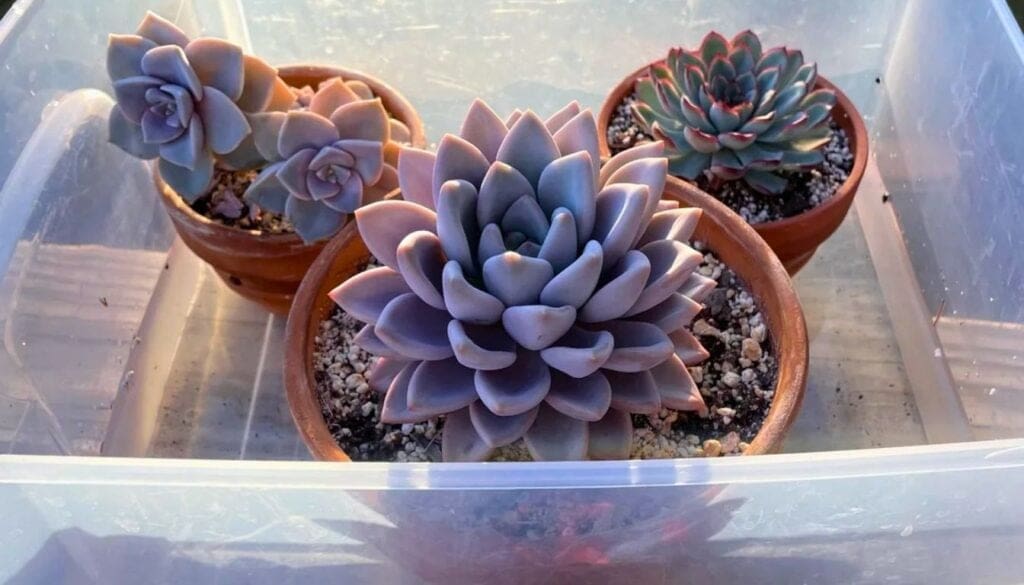
In winter, succulents need less water.
I usually cut back on the watering and only give them a drink when the soil feels bone dry. Too much water can make them unhappy.
Overwatering is the enemy, as it can cause the roots to rot.
Instead of a weekly schedule, I check the soil moisture first.
A simple finger test works wonders: stick your finger about an inch into the soil. If it feels dry, then it’s time for some water. 👍
The Right Soil Mix for Winter
For winter, soil choice is super important for my succulents.
They need well-draining soil to avoid waterlogging. I usually mix potting soil with a bit of sand or perlite.
This creates the perfect home for their roots.
Have you tried this blend? Let me know!
A good tip is to repot them before the cold arrives if needed. Fresh soil means happy roots! 🌵
Succulent Nutrition Before the Cold
Feeding my succulents before it gets cold is a must.
I use a mild, balanced fertilizer in early fall to give them a little extra boost.
But remember, don’t overdo it! A small dose is enough to get them ready for winter.
Once winter arrives, I stop fertilizing.
Do you prep your plants for the season too? Share your tips below! 🌿
Done right, these steps help keep my succulents thriving. 🪴
Proper care leads to happy and healthy plants, even through the cold months.
Feel like adding some of these tips to your habit? Drop your thoughts or questions in the comments!💬
Winterizing Outdoor Succulents

Getting outdoor succulents ready for chilly weather is important to ensure they survive and keep looking amazing.
I’ll share tips on keeping them cozy with insulation, using protective covers, and finding the best spots for sunlight and warmth even in cold weather. 🌵✨
Insulating Techniques
Have you ever thought of giving your succulents a warm blanket? Insulating is like tucking them in for winter.
Adding a layer of mulch or rocks around the base can help keep the cold air out and the warmth in. I often use bark or straw since they provide good protection and let the soil breathe.
Got some extra bubble wrap lying around?
You can use it to wrap pots (not the plants) for additional insulation.
It’s a great trick to keep the roots from freezing, especially in colder climates.
Using complexes like Styrofoam beneath pots can also prevent chilling from the ground below.
Consider lifting pots slightly off the ground. This tiny gap created by pot feet or bricks can save your plants from icy surprises.
Talk about a cozy little hack, right? 😊
Protective Coverings
I like to think of protective coverings as cozy jackets for my plants!
You can use frost cloths, which are easy to drape over your succulents during chilly nights. They let air and sunlight through while keeping frost away.
You could even use a bed sheet in a pinch if it’s not too heavy.
Ever try building a mini greenhouse?
Plastic tents or cloches over your succulents make a fantastic shield against frost and cold winds, acting like a little greenhouse to trap warmth during the day.
But remember, too much cover can be a bad thing.
How about checking on your plants and removing covers when it warms up? This stops them from getting too hot and provides more daylight!
Positioning for Shelter and Light
Finding the right spot for succulents is like finding the comfiest chair in the room.
I always look for a south-facing wall because it will retain more warmth and soak in loads of sunshine.
It’s like giving your plants a sunny vacation in winter!
Near the house, under eaves or balconies, is another good spot. These areas provide shelter against harsh winds and storms.
Have you tried moving your pots there? It’s a simple move that can save them tons of trouble.
Remember to rotate them a bit. Giving each part a chance to catch some sun helps them grow evenly.
Have your own special spot where succulents thrive? Share it with me! 🌞
Caring for Indoor Succulents in Winter
When it’s cold outside, succulents need special love indoors. They require the right temperature, light, and watering to stay healthy and happy.
Let’s make sure these cute, hardy plants keep thriving all winter long. 🍃
Optimizing Indoor Temperature and Humidity
I find it best to keep the room between 60°F to 75°F.
Succulents don’t like very cold air, so keep them away from drafts or chilly windows.
In winter, the air can be quite dry. Humidity levels should be around 40% to 50%.
I use a small humidifier or place a bowl of water near the plants. You’d be surprised at how much they appreciate it!
Check the temperature and humidity regularly. You’ll often find them in perfect condition with these adjustments. ❄️
Light Requirements and Artificial Lighting Options
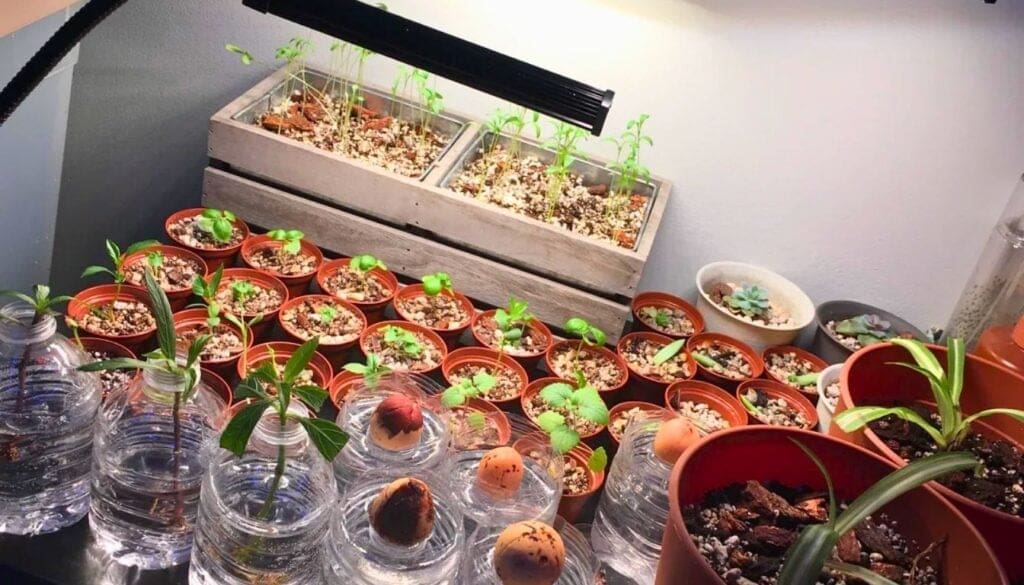
I love watching the sun shine on my succulents, but in winter, sunlight isn’t always enough.
Place them near a south or west-facing window for the best natural light.
If the days are too short, LED grow lights work wonders. They provide consistent light without overheating the plants.
I recommend a 6-8 hour lighting schedule for optimal growth.
Daily rotation of the plants helps them grow evenly.
Anyone else enjoy fussing over their plants as much as me? 🌞
Watering Indoor Succulents in Winter
This might surprise you, but succulents need less water in winter.
I water mine every two to four weeks, depending on how dry the soil feels.
Make sure the soil drains well, too. Overwatering is a big no-no since it can lead to root rot.
Only water when the topsoil is completely dry.
Sometimes, even just misting the leaves can freshen things up.
Who else loves pampering their succulents with a gentle spray? 💧
I’d love to hear your tips and tricks. How do you take care of your succulents in the winter? Share your thoughts in the comments! 🌿✨
Common Mistakes to Avoid
Oh no! Have you ever forgotten to bring your succulents inside on a chilly night? 🌨️ I have, and trust me, they didn’t appreciate it.
Neglecting to protect them from cold temperatures is a big no-no. Remember, keeping them outside when it’s frosty can lead to a plant disaster.
Overwatering is another classic mistake. When winter hits, succulents need less water.
I know it’s tempting to water them like usual, but in cold weather, they can suffer from too much moisture. Remember: less is more in winter.
Placing your succulents in a low-light area can also be a mistake. They still need sunlight to stay healthy, even in winter.
Try to find a spot in your house that gets plenty of sunlight. You’ll notice the difference in their colors and growth. 🌞
Have you ever tried to fertilize your succulents in winter? I made that mistake once, thinking it would help them grow.
Avoid fertilizing during the colder months—it can actually do more harm than good. Save that for the growing season.
Share your own tips or funny mistakes in the comments. Do you have a succulent survival story? 😂 Let’s chat!
Succulent Recovery Post-Winter

Spring is a time for your succulents to bounce back after the winter cold. You’ll want to spot any damage and help them adjust to the warmer days ahead. Let’s dive into the key steps. 🌱✨
Assessing and Treating Cold Damage
First, I gently check each plant. Do the leaves look soft or mushy? If yes, that’s a sign of cold damage.
I snip away these parts with clean scissors, leaving healthy tissue behind. Don’t worry—many succulents are tough and can recover well.
Is the main stem firm? Great! A mushy stem might lead to rot.
If needed, I repot the succulent using fresh soil to keep it happy and disease-free. I always keep an eye on its water needs, too.
Remember, succulents don’t like to sit in soggy soil.
Transitioning to Spring Care
Spring is like a fresh start for succulents! 😊 I gradually move them into more sunlight over a few weeks.
Direct exposure too quickly might cause sunburn. Ouch! So I start with indirect light, increasing it slowly.
My watering routine changes, too. As temperatures rise, succulents drink up more water.
I water thoroughly but let the soil dry in between. Isn’t it amazing how nature’s cues guide us? Anyone else getting serious spring fever?
By adjusting the care routine, succulents thrive beautifully during spring! Let me know how your green friends are doing as the days get warmer.
What’s your favorite part about bringing your plants back to life after winter? Share in the comments below! 🌵☀️
Selecting Succulents for Cold Climates
Living in a chilly area and still want your succulents to thrive? No worries, I’ve got some cool (pun intended 😉) succulents for you to try!
Some succulents can tolerate frost and cold temperatures. They’re tough guys! Sedum and Sempervivum are two great options. These guys are like the winter warriors of the plant world.
When you’re picking out these tough succulents, I suggest checking out their hardiness zones.
Succulents like the Sedum typically do well in zones 3-9, while Sempervivum might surprise you with its cold resistance in zones 4-8.
Did you know succulents have evolved to store water in their leaves? They’re kind of like nature’s version of a camel!
So, they don’t mind a bit of cold as long as they’re not sitting in water-logged soil.
These plants love well-draining soil! To make them feel at home, I recommend using a gritty soil mix.
You can even try mixing sand or small pebbles into your potting mix for extra drainage.
What’s your favorite cold-hardy succulent? Maybe you’ve got a story to share about a particularly tough little plant! 🌵💪 Leave it in the comments—I’d love to hear all about it!
Additional Tips for Succulent Longevity in Winter
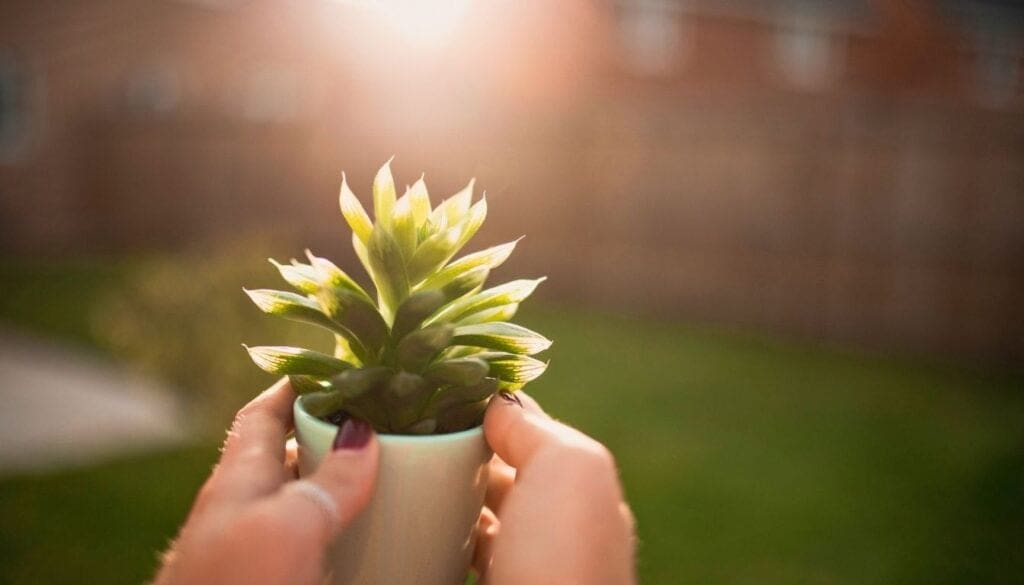
When winter comes, keeping our succulents happy and healthy can be a challenge. I’ve got a few extra tips to help them thrive during the colder months. Let’s dive into it! 🌵❄️
First, let’s talk about watering. I water my succulents less in winter. They don’t need as much because they’re not growing as actively.
I hardly water them once every four weeks. Too much water and cold weather can rot their roots, which is definitely something we don’t want.
Light is another biggie! I try to put my succulents where they can get bright sunlight. Windowsills or sunny spots are perfect places.
If they start looking stretched or “leggy,” they might need more light.
Temperature is crucial, too. I make sure my succulents are away from chilly drafts or freezing windows.
Somewhere around 60-75°F (15-24°C) keeps them cozy. Does your home have any particularly cold spots?
If your succulents are in pots with drainage holes, you’re ahead of the game! This helps prevent soggy roots and keeps them safe and dry.
Here’s a quick idea: Why not place a small indoor thermometer near your plants?
It’s always fun to make sure they are living their best life. What do you think?
Feel free to comment with your own tips or questions. We can make sure our succulents stay green all winter long. Happy planting! 🌿✨
Frequently Asked Questions
I’m here to keep your succulents thriving this winter! Whether it’s protecting them from frost or knowing how much to water, I’ve got some handy tips below. 😊 Let’s make sure those tiny plants get through the cold in style!
What are the best practices for keeping succulents alive during the winter months?
Bringing succulents indoors is key! Make sure they’re near a window to soak up any available sunlight.
You might find yourself rearranging furniture, but trust me, it’s worth it. 🌞
What are some effective methods to protect succulents from frost and snow?
Frost cloths are a fantastic choice. If you’re like me and don’t own any, an old bed sheet works wonders.
Just make sure not to touch the leaves directly. Do you have a favorite trick? Tell me about it! ❄️
How often should I water my indoor succulents when the temperature drops?
During the colder months, I slow down on the watering schedule.
Water once every 3-4 weeks. They won’t complain! Their soil should dry out completely before the next watering.
Are there specific types of succulents that can withstand freezing weather?
Yes! Sedum and Sempervivum varieties are champs in the cold.
Have you tried growing these frost-hardy plants? If they braved last winter’s chill, give them a pat or…some water!
What should I do to revive a succulent that has been damaged by cold?
First thing, trim away any mushy leaves. Let’s give them a little trim like a new haircut!
Sometimes, starting fresh is what they need. Also, ensure they’re in a warm, bright spot to recover.
Can I leave my succulents outside during winter, and if so, how can I prepare them?
Absolutely, but they need some love! Move them closer to a wall, which can offer extra warmth.
If you’ve got a mini greenhouse, even better!
Are there spots in your garden that are like cozy corners? I’d love to hear! 🌿
Why don’t you tell me your strategies? Share your stories or ask questions below!
Let’s tackle this winter one succulent at a time! ❄️🌵
Recommended Garden Supplies
| Product Image | Our Recommended Gardening Supplies | Check Offers! |
|---|---|---|
Top Top
Top
Top
Top
Top
Top
Top
Top | rePotme Houseplant and Tropical Classic Potting Soil Mix | Check Offer On Amazon |
 Top
Top
Top
Top
Top
Top
Top
Top | Espoma Organic Indoor Plant Food | Check Offer On Amazon |
 Top
Top
Top
Top
Top
Top
Top
Top | GooingTop LED Grow Light 6000K Full Spectrum Clip Plant Growing Lamp | Check Offer On Amazon |
 Top
Top
Top
Top
Top
Top
Top
Top | Soil Moisture Meter | Check Offer On Amazon |
 Top
Top
Top
Top
Top
Top
Top
Top | Govee Hygrometer Thermometer, Bluetooth Enabled! | Check Offer On Amazon |
 Top
Top | LEVOIT Humidifiers for Large Room(Best For Plants) | Check Offer On Amazon |
 Top
Top
Top
Top
Top
Top
Top
Top | Upgraded DIY Automatic Drip Irrigation Kit, 15 Potted Houseplants Support | Check Offer On Amazon |
 Top
Top
Top
Top
Top
Top
Top
Top | Stainless Steel Heavy Duty Gardening Tool Set | Check Offer On Amazon |
 Top
Top
Top
Top
Top
Top
Top
Top | Bonide Insecticidal Soap | Check Offer On Amazon |
 Top
Top
Top
Top
Top
Top
Top
Top | Bonide 32 oz Spray Neem Oil for Organic Gardening | Check Offer On Amazon |
 Top
Top
Top
Top
Top
Top
Top
Top | Garden Safe Fungicide | Check Offer On Amazon |



